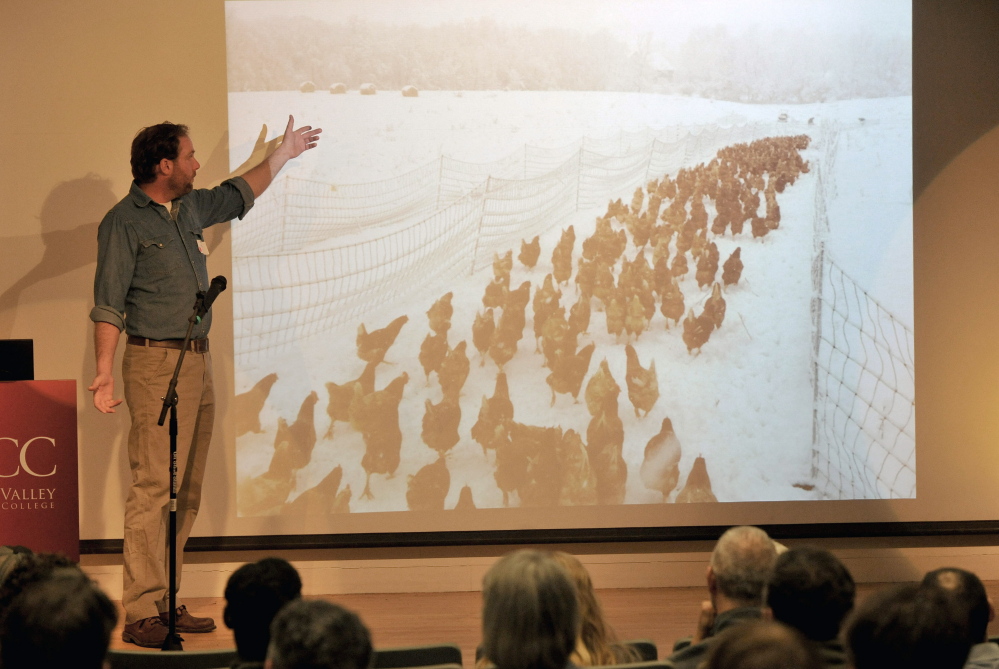FAIRFIELD — Roughly 100 grass farmers from all over New England descended on Kennebec Valley Community College Saturday for a daylong conference meant to help teach them to maximize profits in the ever-shifting world of farming.
The event, hosted by the Maine Grass Farmers Network, targeted livestock farmers who wanted to maximize the value of their animals by better managing the pastures they’re raised on.
The composition of the crowd — some old, some young, some men, some women, all of whom had plunked down $75 to attend — reflected the increasing diversity of an agricultural industry that has broadened its appeal over the last decade.
The latest agricultural census from the U.S. Department of Agriculture shows that between 2007 and 2012, the number of farms increased, as did the number of female farmers and young farmers with limited experience in the field.
Over that period, the number of Maine farmers aged 34 or younger grew from fewer than 400 to more than 550. At the same time, the number of farmers aged 45 to 54 years shrank, from 2,277 to fewer than 2,000. The number of female farmers increased too, from about 2,000 to nearly 2,400.
Not surprisingly, the number of farmers with two years of experience or less jumped from 250 to 373, which means a new class of farmers is emerging, and they are eager to learn new techniques that will help them to navigate an extremely complex field.
The challenges of farming became apparent during a session about cover crops led by Kristen Workman, of the University of Vermont.
“I’ve been asking the question, why not grow cover crops?” she said. “To me, it’s a no-brainer.”
The idea of a cover crop is simple — in addition to planting a primary crop for harvest, such as corn, a cover crop can be planted to add nitrogen to the soil, prevent erosion, crowd out weeds and provide forage for cattle.
But planting a successful cover crop means knowing what to plant, when to plant it and how to get it into the ground, all of which are dependent on the individual farm’s needs and the year’s weather conditions.
Workman spoke about the benefits and drawbacks of a staggering variety of cover crop candidates, including winter wheat, winter rye, hairy vetch, Japanese millet, clover, Sunn hemp, tillage radish, oats, Sudangrass and winter triticale, among many others.
“Quick rye is a higher yield, but it’s a lower quality than triticale,” she told the attentive audience, drawing on her experience with her own farm in Vermont’s Champlain Valley. “Still, you get less nutrients per acre with triticale.”
Farmers, thinking about their own plots back home, asked many questions.
What was the difference in triticale protein levels between the spring and the fall? Was Italian rye grass a good source of nitrogen? Would cows eat tillage radish, and how much protein would they get out of it? Would clover suppress weeds effectively?
In some cases, Workman said, the best answer is to do an experiment on a small portion of one’s own farm and compare the results.
Planting the cover crop in a way that won’t disrupt the harvest crop is also an issue. Workman said she has tried many methods, including broadcasting 100 pounds of seed per acre by helicopter.
“In the Midwest they use airplanes, which are cheaper, but we’re not set up that way around here,” she said. “We don’t have fields that are long with nothing around them.”
Barbara Skehan, owner of Twin Brooks Farm in Chelsea, said she comes to the conference every year.
“Every year we learn something helpful,” she said.
This year, she said, she was impressed by keynote speaker Forrest Pritchard, who owned a Washington, D.C.-area farm and has branched out into public speaking and writing. Pritchard’s ideas about how different domesticated species could share the same pasture made sense to Skehan, who said she might try to implement a new watering system that would serve the needs of her chickens and her beef cattle.
Sibongile Sithe, an employee of the hosting community college, said she might use the information she learned to improve the farm management practices in the college’s ambitious efforts to revitalize a working farm on its new campus.
Sithe said she was most impressed to learn about low-cost labor-saving pieces of infrastructure that could help improve a farm’s profitability.
For first-time attendee Brian Grosse, who bought Highland Pasture Farm in Dover-Foxcroft just two years ago, the conference was a wealth of information.
Grosse owns about 35 cattle, which are grass-fed and destined for the meat market in Boston.
He said he learned new grazing methods that take conventional wisdom and turn it on its ear.
“The old school idea was to allow the cattle to graze to a certain stubble height,” he said. At the conference, he said he’d learned to allow his animals to only take 30 percent of the forage, while trampling the remaining 70 percent down into the ground, improving the earth during each rotation.
The conference was sponsored by the University of Maine Cooperative Extension; The Maine Organic Farmers and Gardeners Association; The Natural Resources Conservation Service; The Maine Department of Agriculture, Conservation and Forestry; and the Maine Beef Producers Association.
Matt Hongoltz-Hetling — 861-9287 mhhetling@centralmaine.com Twitter: @hh_matt
Send questions/comments to the editors.



Success. Please wait for the page to reload. If the page does not reload within 5 seconds, please refresh the page.
Enter your email and password to access comments.
Hi, to comment on stories you must . This profile is in addition to your subscription and website login.
Already have a commenting profile? .
Invalid username/password.
Please check your email to confirm and complete your registration.
Only subscribers are eligible to post comments. Please subscribe or login first for digital access. Here’s why.
Use the form below to reset your password. When you've submitted your account email, we will send an email with a reset code.